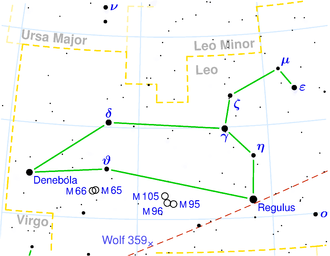NGC 3300
| Galaxie NGC 3300 | |
|---|---|
 | |
| SDSS-Aufnahme | |
| AladinLite | |
| Sternbild | Löwe |
| Position Äquinoktium: J2000.0, Epoche: J2000.0 | |
| Rektaszension | 10h 36m 38,4s[1] |
| Deklination | +14° 10′ 16″ [1] |
| Erscheinungsbild | |
| Morphologischer Typ | SAB(r)0^0^: [1] |
| Helligkeit (visuell) | 12,3 mag [2] |
| Helligkeit (B-Band) | 13,3 mag [2] |
| Winkelausdehnung | 1,7′ × 0,9′ [2] |
| Positionswinkel | 173° [2] |
| Flächenhelligkeit | 12,6 mag/arcmin² [2] |
| Physikalische Daten | |
| Zugehörigkeit | LGG 207 [1][3] |
| Rotverschiebung | 0.010270 ± 0.000060 [1] |
| Radialgeschwindigkeit | (3079 ± 18) km/s [1] |
| Hubbledistanz vrad / H0 | (133 ± 9) · 106 Lj (40,9 ± 2,9) Mpc [1] |
| Durchmesser | 70.000 Lj |
| Geschichte | |
| Entdeckung | Wilhelm Herschel |
| Entdeckungsdatum | 19. März 1784 |
| Katalogbezeichnungen | |
| NGC 3300 • UGC 5766 • PGC 31472 • CGCG 065-066 • MCG +02-27-030 • IRAS 10410+1507 • IRAS 10409+1508 • 2MASX J10363843+1410175 • GC 2148 • H III 55 • h 727, h 3273 • LDCE 0740 NED003 | |
NGC 3300 ist eine linsenförmige Galaxie vom Hubble-Typ SB0 im Sternbild Leo an der Ekliptik. Sie ist schätzungsweise 133 Millionen Lichtjahre von der Milchstraße entfernt und hat einen Durchmesser von etwa 70.000 Lichtjahren.
Das Objekt wurde am 19. März 1784 von William Herschel entdeckt.[4]
Weblinks
Einzelnachweise
Auf dieser Seite verwendete Medien
Autor/Urheber: Sloan Digital Sky Survey, Lizenz: CC BY 4.0
The sky image is obtained by Sloan Digital Sky Survey, DR14 with SciServer.
Angle of view: 4' × 4' (0.3" per pixel), north is up.
Details on the image processing pipeline: https://www.sdss.org/dr14/imaging/jpg-images-on-skyserver/Autor/Urheber: Copyright © 2003 Torsten Bronger., Lizenz: CC BY-SA 3.0
This is a celestial map of the constellation Leo, the Lion.




